Don't wanna be here? Send us removal request.
Text
Look at Animal House 2 - by Ed Fornieles. The house as site, site specific can mean more than initially thought.
0 notes
Text
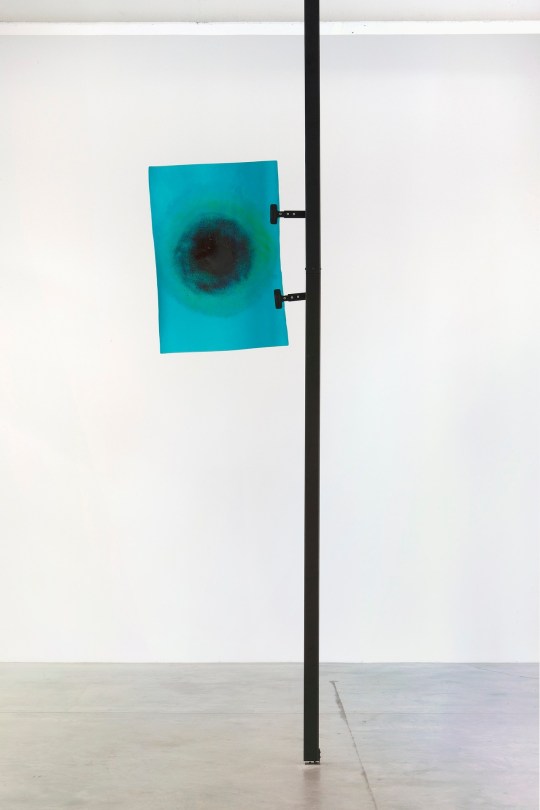



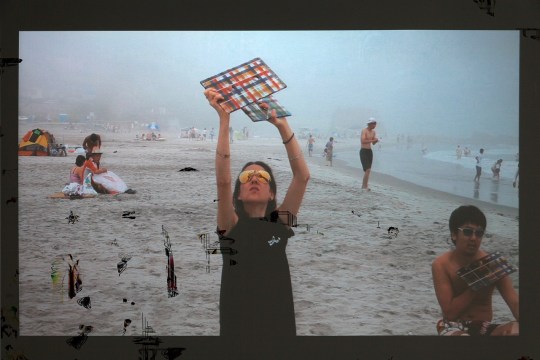
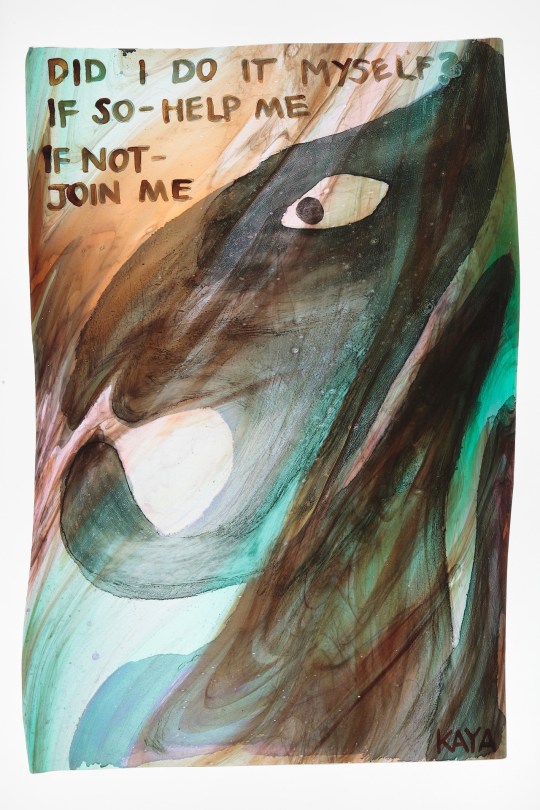


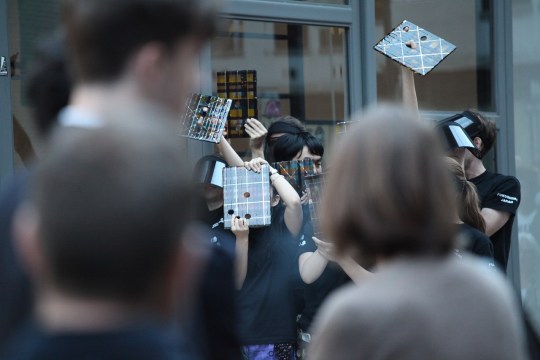
Kerstin Brätsch
MALER, DEN PINSEL PRÜFEND - THE 2ND QUASI
Gavin Brown's Enterprise, New York. September 29 – October 27, 2012
I find this exhibition and body of work really interesting, as we are seeing many stages of how it came to be, and where it could go. And lots of collaboration. The exploration of painting as medium, that leads to stained glasswork, and then considering how these works can be held and presented on moveable 'arms' to affect the viewer's experience, described as more like "film mediating the light of a projector." The metal arms and frames are made by another artist, as is the glass - in conversation. Then we see documentation of, and hear in writing, the places this glass has been and how it has been used to capture light. Photographs of people holding and using it. Like material that is beautiful and useful! Then collaborative performance in the gallery space, and the hometown of the performer duo in Fukushima, Japan.
Press release linked below. I found this interesting to read.
Gallery opening hours: sunrise - sunset. again using light to control viewer's experience
Name of exhibition comes from Schlemmer painting - again Bratsch drawing from another artist, who was in turn reflecting on his experience of working in collaboration with a commercial lacquer company, looking at samples and then painting by night.
Snowball being rolled over and over, getting bigger and more layered.
0 notes
Text






Lindsay Seers - 'Nowhere Less Now' in the Tin Tabernacle - ArtAngel project, 2012.
Something viewed from inside. Navigating way into internal of an object/space. Not necessarily non descript from outside, but must find way into the work. Not sure what is direction to the work, and what is the work. Both.
Using existing clues of a space.
0 notes
Text
Atelier van Lieshout
workshop set up by joep van lieshout. play, huge structures - views himself as a rhino - working working working .
utopuia/dystopia - eco city designed for slaves.
'my work always some relationship with the idea of usage. even when you can't actually use it, it's saying something about usage. or i'm using it's usage to express some artistic idea.'
making furniture and homes - it is it art that is much closer to people's lives
inventions - interested in complex systems , function of things - the body's organs on big scale, also trying to shrink down humans to better suit the planet today

0 notes
Text
Stuart Middleton - keep going - snail animation video.
shown in 'Motivation and Personality' exhibition of his work. Found this article very packed with things...
https://www.carlosishikawa.com/site/assets/files/3092/2019-stuart_middleton-_mousse-_formatted.pdf
https://www.carlosishikawa.com/site/assets/files/3092/2017-stuart_middleton-_cura-_formatted.pdf
0 notes
Text
youtube
3/10/2023
Caroline Aherne in Fast Show. Checkout Girl. The other night, I was watching Royle Family, then Mrs Merton Show, and Caroline Aherne sketches... shows she'd written. Really funny. And the language is quite specifically structured, the gaps of silence and looks between, and very of real life, in that moment, not attempting to create a backdrop 'plot' surrounding it, that then interrupts the believability of it. Relying on its closeness to reality and leaning into the absurd elements, not trying to overexplain. I liked this particular clip because I've been thinking about staging a video/performance in the Lidl. Impersonating an employee, by wearing the full Lidl merchandise clothing that they sell, interacting with my "colleagues", asking people if they need help, pretending to use checkout. Beep, beep... pretend money. Not sure if I'd actually have guts to do it, but maybe! Or at least I should by the full outfit, to wear around. (Next small art school exhibition opening).
1 note
·
View note
Text
Lygia Clark
A pioneer of participatory art in the 60s. She had a recent retrospective of her work at MoMA.
https://www.theguardian.com/artanddesign/2014/may/29/lygia-clark-review-art-moma-new-york
Critter works and Bichos ( Creatures) made from hinges allowing the viewer to interact with them and change their shape. Made in maquette form, then also scaled up for public sculptures.
https://hyperallergic.com/142956/the-radical-brazilian-artist-who-abandoned-art/
https://wsimag.com/architecture-and-design/10811-lygia-clark-fantastic-architecture



1 note
·
View note
Text
Dundee
Saw three exhibitions - Rae-Yen Song and Tako Taal (in DCA) and Michael Clark in V&A - amazing! Found the Michael Clark exhibition so inspiring. Loved the dance/performance, the costumes, how he worked with musicians (Like The Fall) and the body becoming like an instrument in a circle of heavy bass and guitar. Saw bits from Hail the New Puritan. Really interesting how fiction is constructed in this documentary style film - subtle narrative and exaggerated characters. Use of the real world and then elaborate set - I loved the fried eggs taken from Trojan’s paintings, Leigh Bowery’s costumes, I am Curious Oranj, the spinning burger with Brix Smith on top of it...
I would like to experiment more with video and maybe trying to create sets for within these worlds. Using found footage and putting this within a film (like two worlds both happening at once), creating “stages” in public/real life space? Sets people can walk through, in, around, looking at the end/beginning of these spaces.
https://www.youtube.com/watch?v=u3CeMnoqkPI&list=TLPQMTQwMzIwMjJELZ9muZFhEg&index=4
0 notes
Text
Judy Chicago early/minimal work - games and objects
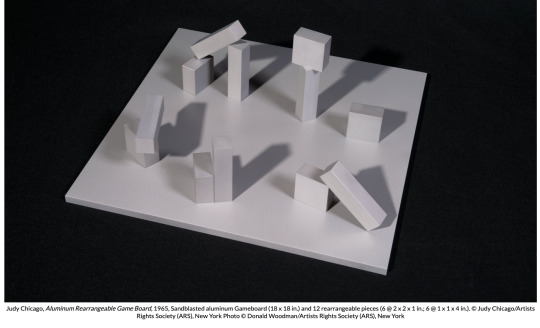
I had a look at the book - JUDY CHICAGO – TO SUSTAIN THE VISION by Géraldine Gourbe, in Good Press. I liked her early work which took on the form of games, rearrangeable parts and joining multiple elements.
Similarities to my interests in a game/tactile activity people can become involved in , like with my spinning wheel and the waiting space abacus im making at the moment. In my public art project I could think about using this format to create something for people in public space. use the invitation of touch, involvement, play (not necessarily “play” as I think his word can sometimes limit what the work is, that it is just fun and without moral dilemma) to make work and link it to the public and the place.
I cycled along the river at Glasgow green, towards cuningar loop, saw the leaving Glasgow sign, there was boating club building - a Glasgow uni one which looked abandoned. I liked the colours, reminds me of the coloured gates at the necropolis . interesting space I could use - a previous site of activity that could be reused, reactivated . also might look at catkin park for same reason - used to be matches there. not that I'm a big football follower, but my family is and sometimes I think its an interesting dynamic I could think about. that disconnect.
I like the idea of looking at river, a historical site, things buried down there. how things have formed along it. Clyde Environment photos by George Oliver, could get out of the gas archive.
0 notes
Text
Jeremy Deller show at The Modern Institute










I went to see the Jeremy Deller talk in the Modern Institute. I enjoyed the work to an extent, but I think there were questions I had about how Jeremy Deller positioned himself in the work. It seemed to cover a lot of different social issues, but I wonder who has the authority to speak on them…and at the same time I think the work is presented as something eye-catching and relatable, that anyone can understand, I think particularly with the graphic style, but I wonder if it actually caters to quite a specific intellectual, ‘arty’ audience. But maybe that doesn’t matter? and Deller is confident in presenting his specific commentary. For example, the use of Hebrew - there was little explanation in why the original English poster was also translated and printed into Hebrew, and how should we feel about the appropriation/use of language? Deller said they had actually got the translation wrong, which bothered me, as I feel it’s important to apply the same care, and research.
The talk was in the dark, with Deller shining a torch on different pieces, some of them fluorescent. I liked the posters for imaginary exhibitions - interesting proportions for ideas that could happen. Blending actual culture with imagined narrative. Also nice little written notes under the work.
0 notes
Text
Janet Cardiff
How can I take the viewer on an experience? Allow them to be part of a sculptural/instillation work, but in an immediate way that means they fully experience the walk I am trying to document? I felt quite inspired by Cardiff’s use of sound to create a physical experience, that weaves in fictional story, sensory elements, places the viewer in a new world. I first looked at the audio walk she created for Munster Sculpture Projects 1997 - ‘Walk Munster’. She combines site specific sounds that actually exist with artificial sounds, to create the between/other space. There is a fictional narrative that the viewer becomes part of, telling them about things that aren't actually there. In encountering places and moments on my walk, I started to think about how I could create reimaginings and fictions from these places and objects - like ‘Daphne Luna Buzz’, the band that came from the graffiti on the gates. And the radio audio I recorded, to be played from within my motorway model, so as to attach a certain emotive sound to a specific place (and time?).


https://www.skulptur-projekte-archiv.de/en-us/1997/projects/72/
I found it interesting to hear about how Cardiff discovered binaural recording as a medium, and how it could be a sculptural work. “I had found a way to be in two different places at once. I was able to stimulate space and time travel in a very simple way.” she said in the introduction to the book, ‘The Walk Book’.
https://issuu.com/tba21/docs/the_walk_book_complete
https://fortynotes.wordpress.com/2011/03/03/janet-cardiffs-audio-walks/
“The idea of commissioning of an audio piece for traditional sculpture festival provoked a realisation for Cardiff. The idea was the “walk as sculpture.” “
The artist is in control of how the audience perceives the space, in an audio walk. Next time I’m in London I’m going to go on an audio walk Cardiff created around the Whitechapel area. I related to what she was saying about why she created the walk, and where the ideas came from.
“Sometimes I don’t really know what the stories in my walks are about. Mostly they are a response to the location, almost as if the site were a Rorschach test that I am interpreting. For me, The Missing Voice was partly a response to living in a large city like London for a while, reading about its history in quiet libraries, seeing newspaper headlines as I walked by the new stands, overhearing gossip, and being a solitary person lost amongst the masses. Normally, I live in a small town in Canada, so the London experience enhanced the paranoia that I think is common to a lot of people, especially women, as they adjust to a strange city.”
https://cardiffmiller.com/walks/the-missing-voice-case-study-b/
https://soundcloud.com/artangel-2/talk-the-missing-voice-01
0 notes
Text
Francis Alys
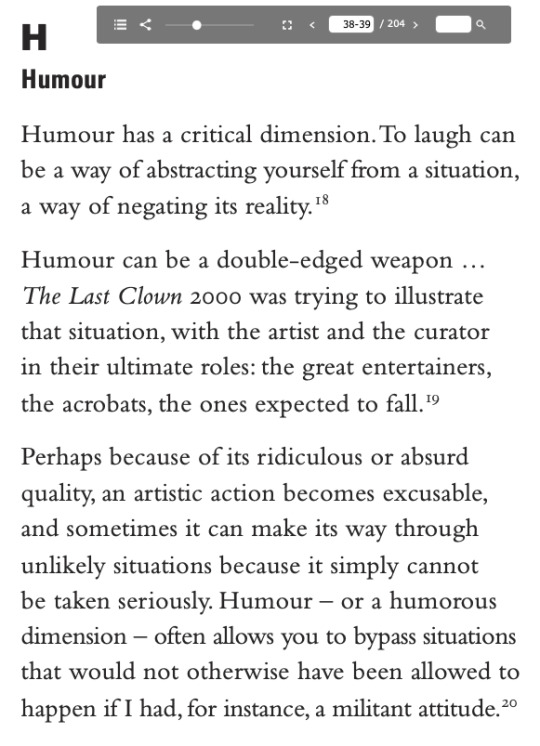
^ From the chapter ‘A-Z of Francis Alys’ from ‘A Story of Deception’.
I watched a short video of Alys talking about their instillation - ‘The Last Clown’. I found it interesting to hear about how Alys developed their work from conception of an idea to this evidence of process/outcome. The main element, the animated film, he talked about as ‘evidence of the whole process” - and the process having the essence of the work within it. Their was an archive of lots of drawings alongside the film, and a series of paintings that led to the animation. Alys talked about the obsessional quality of the archive, almost like having to capture every part of the process and it being just as vital as a more polished, concluded piece.
https://youtu.be/mQZnussmPoU
The idea of “artist as the last entertainer”, coming from a conversation and walk with a curator friend, led to an explorative piece of work that played with this idea continually. I like the playful tone and approach that suggests the work is never really finished, and can continue to be changed/added to. The theme also removes the idea that the artist’s perspective is more important than anyone else’s, they re here to provide for an audience and to give, rather than force their viewpoint on anyone. I also looked at Alys’ work, ‘The Commuters’, from a series of work called ‘Seven Ways’. It plays with the idea of authorship, who makes the work? And is the artist just the curator and documenter of the outcomes? There are multiple components - instructions, the original painting, the photos showing visitors taking the painting away. It can continued to be added to, as more visitors take the painting - and therefore become the artist? The work comes from walks Alys took around London. The work is research and the generating of material then...

https://www.artangel.org.uk/artwork/the-commuters/
https://www.tate.org.uk/art/artworks/alys-the-commuters-t12183
0 notes
Text
Francis Upritchard
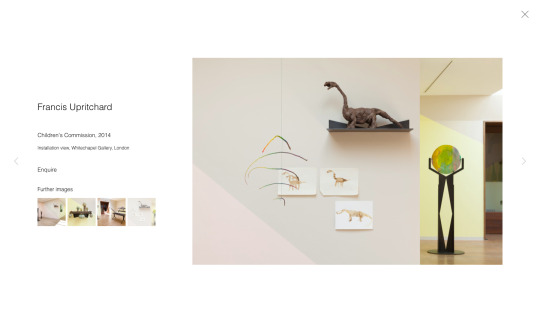



I looked at Upritchard’s work after making the plasticine figures of my fictional band, ‘Daphne Lunar Buzz’. I was drawn to the artist’s imaginary creatures and figures, and I think it’s interesting how they are shown in groups or as part of a collection of objects. It makes them feel like they’re part of a narrative, or larger context, which the audience isn’t necessarily aware of. But I think the way her instillations are created gives you clues, or tells you about Upritchard’s intention and tone. The titles interest me and make me think what story could be being told - like ‘Potato Poem’. When I showed my work in the crit, people talked about how they were being presented with a collection of some kind, but I think left it up to them to put the pieces together and make connections. It was almost like ongoing research material, or a natural formation of ides that was more personal than public. I didn’t have a title for my wok, and I should definitely try to come up with some - it would be really helpful for the viewer.
In ‘Children’s Commission’ (2014) I like the combination of larger sculptural forms and more delicate drawings and the hanging sculpture, they work together and use the space in an interesting way. Thinking about the way I work, I often like to have multiple elements I’m collecting and working on , and then start to put them together and think about the links between them.
0 notes
Text
Ricerche, Sharon Hayes at Common Guild
I went with my mum to this show, and I think that was good thing, as the work to me seemed to be about conversation and how we talk, rather than only what we talk about. The films brought up topics that me and my mum ended up having conversations about - I think it was interesting way of interacting with the audience. Getting them to recreate conversations that were being had in the film. In the videos we were presented with the subjects of gender, family and community, but in watching the conversations that took place (which were unscripted and natural it seemed, and long and meandering) - it encouraged a conversation in the audience. They felt like documentaries (with less editing), but rather than just dealing with the subject directly, it opened it up and exploring its meanings. Looking at it from different angles and perspectives.
The films themselves didn’t feel like the entirety of the artwork; it was also the prior research and development of relationships between people, the historical context, and then what happened after - that questions it raises - How do we approach these topics? how do different people think about the topics? The interview format interrogated those in the film, put them on the spot but also intently listening.
The films were shown in different rooms and you could join each at any point, so never really saw the full thing of any - it made it a lot of content to think about. And left a lot of choice to the viewer, in which order they watched and how long they stayed.
There was a research room - showing books and resources that influenced Hayes making of the work. Bringing this into the exhibition space made me think about how research and development can be part of the work, and the work can act as a document. I think this idea is important to my work, and I want to consider more my approach to a “final piece” and it’s documentation, play around with what goes alongside each other/what is separate. Also, is my work for a specific audience? Does the work respond to a certain place and time? And should then only be shown in a particular way?
0 notes







